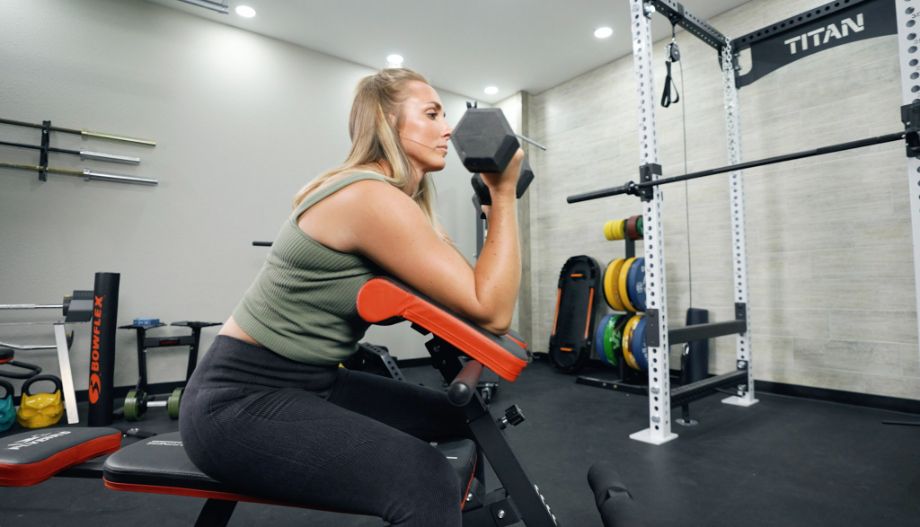We test and review fitness products based on an independent, multi-point methodology. If you use our links to purchase something, we may earn a commission. Read our disclosures.
If you’ve been blasting biceps curls til kingdom come but feel less than blessed with the gains delivered, you don’t need a miracle to build bigger biceps; all you need is a well-rounded arm workout chock full of guaranteed biceps developers, like the preacher curl exercise.
RELATED: Long Head Biceps Exercises
The preacher curl is a popular variation of the classic barbell curl that effectively increases muscle activation to your biceps brachii by stabilizing your elbow joints against a preacher curl bench. The result: god-tier gains!
Kate Meier, NASM-CPT, USAW-L1, CF-L1, and GGR director of fitness content, breaks down the preacher curl, including step-by-step instructions on how to do it with good form, common mistakes to avoid, benefits of performing preacher curls, and more!
How to Do the Preacher Curl
- Adjust the preacher pad extension or incline bench so your upper arms and chest touch the pad.
- Select your barbell or EZ-curl bar and load it to the desired weight.
- Sit with your arms extended, and elbows pressed into the pad.
- Grip the bar using an underhand grip.
- Breathe in, then exhale and curl the bar toward your shoulders.
- Squeeze your biceps at the top position.
- Slowly return the bar to the starting position.
- Repeat as needed for reps.
Muscles worked: Biceps brachii, brachialis, brachioradialis
RELATED: Best Curl Bars
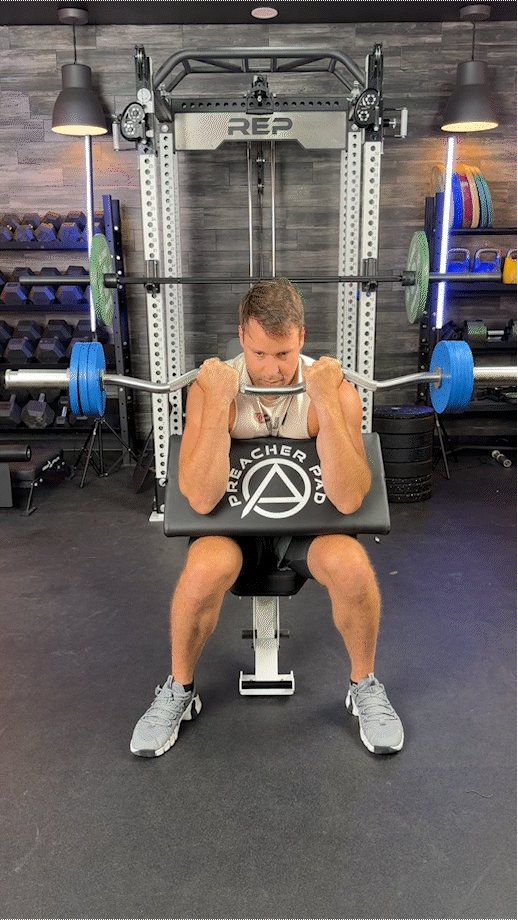
Trainer Tips on Form
You won’t experience the kind of biceps growth you’ve been praying for if you’re not performing the preacher curl with perfect form. Check out our top tips below!
Stay Glued to the Pad
When you sit down at the preacher curl bench, you’ll want to press your chest into the support pad and drape your arms over the top, firmly pressing your elbows into the padding. Your chest and upper arms should stay stationary throughout your entire range of motion.
“The preacher curl is an isolation exercise that really hits the biceps hard by keeping the elbow joint stationary and supported using the pad,” says Kate Meier, NASM-CPT, USAW-L1, CF-L1. “That’s why it’s important to keep those elbows glued to the pad and move only by flexing the elbow and contracting the biceps muscles.”
Use a Full Range of Motion
It’s tempting to shortchange the range of motion when fatigue starts setting in, but, generally speaking, you always want to complete a full range of motion to reap the most reward per rep.
Using a full range of motion is especially beneficial when doing preacher curls because, according to Sports (Basel)1, the initial range of motion “promotes greater distal hypertrophy of the biceps brachii” and “greater dynamic strength increase” versus the final range of motion.
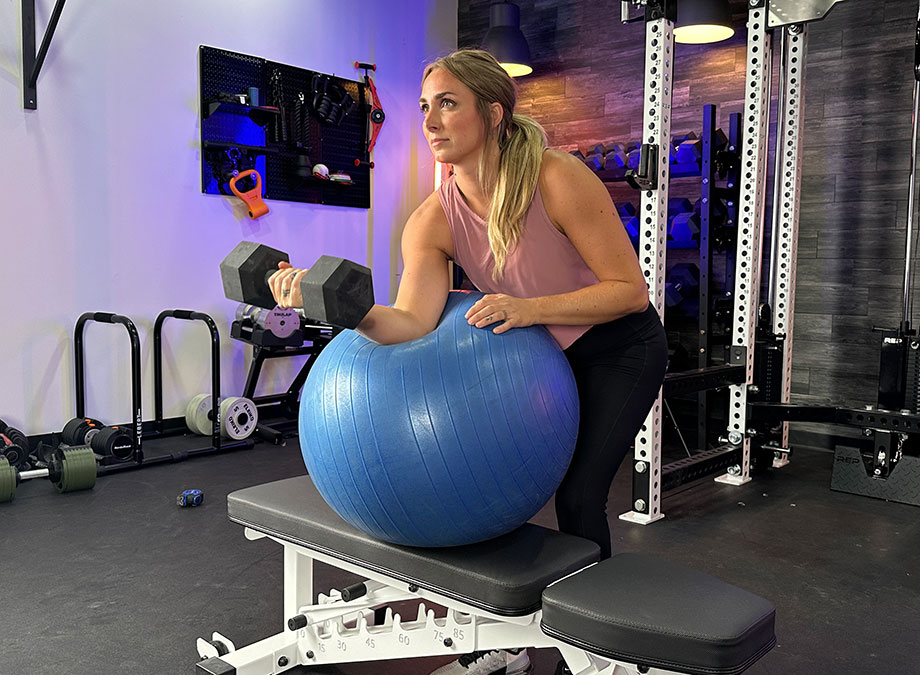
So, the whole range of motion is ideal, but you’re getting the most benefit from the initial portion of the concentric phase and the end portion of the eccentric phase, making it well worth your while to perform full reps only when doing preacher curls.
Besides, repetitions with a full range of motion also maximize your muscles’ time under tension, further compounding those gains. Hallelujah!
Maintain Strong Wrists
“Heavy weights tend to place stress on the wrist joints,” says Kate, “which could result in them buckling or extending while they should be locked in a strong, neutral position.”
If you’re having difficulty keeping your wrists rigid, use a lighter weight and focus on slow reps and a tight biceps contraction at the top.
Similarly, using an EZ-curl bar—which allows a more neutral grip than the supinated grip used with a straight bar or dumbbells—can benefit you by helping reduce wrist stress.
And never underestimate the value of some of the best wrist wraps here.
Preacher Curl Benefits
Adding the preacher curl to your biceps workout can have many benefits for your arm gains. Here are our top three if you need convincing.
May Increase Biceps Strength and Hypertrophy
A well-rounded strength training program featuring the best arm exercises should provide the same garden-variety strength and hypertrophy gains. That said, the isolation mechanics of preacher curls set them apart from the pack because you can target the stubborn muscle groups in your arms and exhaust them properly.
Further proof, according to the Journal of Human Kinetics2, study participants who performed preacher curls regularly showed significant improvements in muscle thickness over nine weeks.
So, if you’re looking for bulging biceps that could make the Austrian Oak himself weep, the preacher curl delivers.
May Help Improve Shoulder Health
“The preacher curl doesn’t only stabilize your elbow joint,” says Kate Meier, NASM-CPT, USAW-L1, CF-L1. “The positioning also keeps your shoulders at a fixed angle, which reduces stress on the glenohumeral (or shoulder) joint, too.”
So, preacher curls place less stress on the shoulder joint, but that’s not all. The biceps muscle attaches via two tendons to the scapula and the shoulder joint, respectively, meaning it plays a role in shoulder stabilization and rotator cuff function.
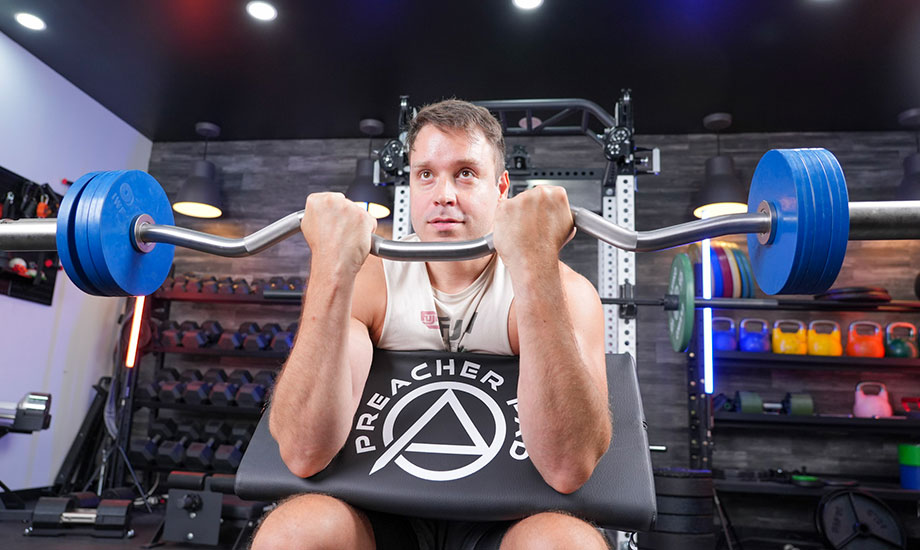
Strengthening the biceps using the preacher curl, therefore, may help assist in improving your overall shoulder health and stability.
May Help Enhance Pulling Performance
Incorporating preacher curls into your upper-body workout should translate to an easier time with other pulling movements, including pull-ups, chin-ups, pulldowns, and rows. By building up your biceps strength, you should expect to see some nice increases in just about any pulling movement.
RELATED: Upper-Body Workout At Home
That enhanced pulling power isn’t reserved for sports and weightlifting, though. Everyday tasks involving pulling—whether opening a door, pulling a shopping cart out of the corral, dragging a suitcase, or rearranging furniture—will also see a marked improvement.
Common Preacher Curl Mistakes
They may look easy enough on the screen, but beginners should pay close attention when learning the preacher curl. Here are a couple of preacher curl mistakes to avoid.
Going Too Heavy
The preacher curl is an incredible isolation exercise for your biceps, but it’s not a powerlifting workout meant for going super heavy every time.
Going too heavy on the preacher curl can really get you into trouble. It can overtax your shoulder, elbow, and wrist joints and increase your risk of injury. It can also damage your biceps muscle beyond the threshold where muscle growth occurs, and it encourages poor form, diminishing your gains.
“Stick to a weight you can lift with proper form for the whole set,” says Kate. “The last one or two reps should be a struggle, but if you’re shaking on rep one, you’re probably overdoing it.”
Drifting Away from the Pad
The distinguishing feature of the preacher curl versus other curl variations is that trademark preacher curl bench and pad combo that allows you to stabilize your upper body and elbow joint to really dig in and keep the focus where you want it— the biceps, of course!
Letting your elbow lift off the pad defeats the purpose and allows you to use other adjacent muscle groups to assist (aka cheat). The same goes for your torso since letting your chest move away from the pad could rope in your back or other muscles you’re not trying to target.
To stop this from happening, maintain a rigid posture throughout the set. Your elbows should stay stationary, firmly pressed into the pad, and your torso, while some movement is okay, should always be touching the pad.
Preacher Curl Variations
So, you’ve got the standard preacher curl down pat, do you? Try these preacher curl variations on for size!
Close-Grip Preacher Curl
Why do it: The close-grip preacher curl increases activation in the long head of the biceps brachii. That’s the part responsible for that classic rounded biceps appearance, making this variation a favorite among bodybuilders and other aesthetically-inclined individuals.
How to do it:
- Set up your preacher curl station as you would for the standard version.
- Sit down and grip the bar with an underhand grip that’s inside shoulder-width.
- Inhale, then breathe out as you curl the bar toward your shoulders using your biceps.
- Squeeze your biceps at the top of the movement, then slowly return the bar to the starting position.
- Repeat as needed.
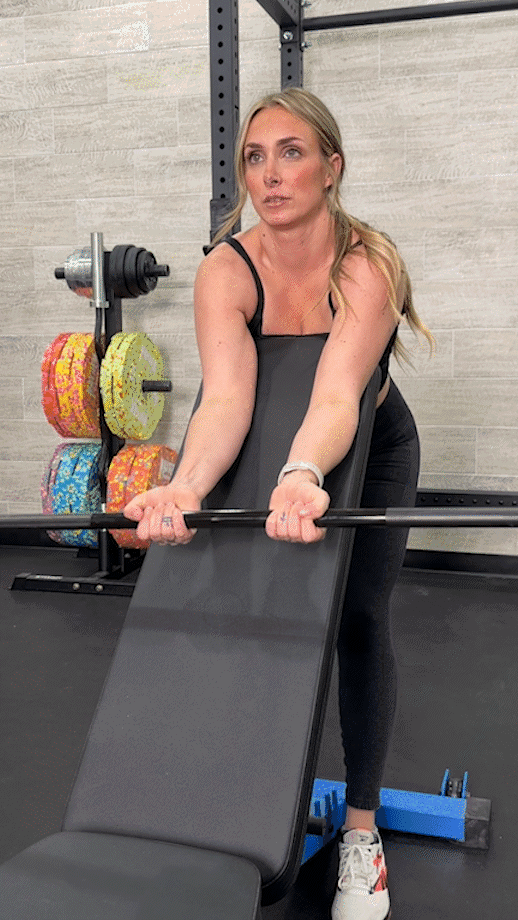
Dumbbell Preacher Curl
Why do it: Most free weights work for the preacher curl, but doing a dumbbell version instead of a barbell or EZ-bar preacher curl lets you address muscular imbalances and bilateral deficits.
How to do it:
- Set up your preacher curl station as you would for the standard version.
- Grab two dumbbells, sit down, and extend your arms over the pad.
- Curl the dumbbells toward your shoulders.
- Squeeze your biceps at the top.
- Slowly return to the starting position.
- Repeat as needed.
RELATED: Best Dumbbells
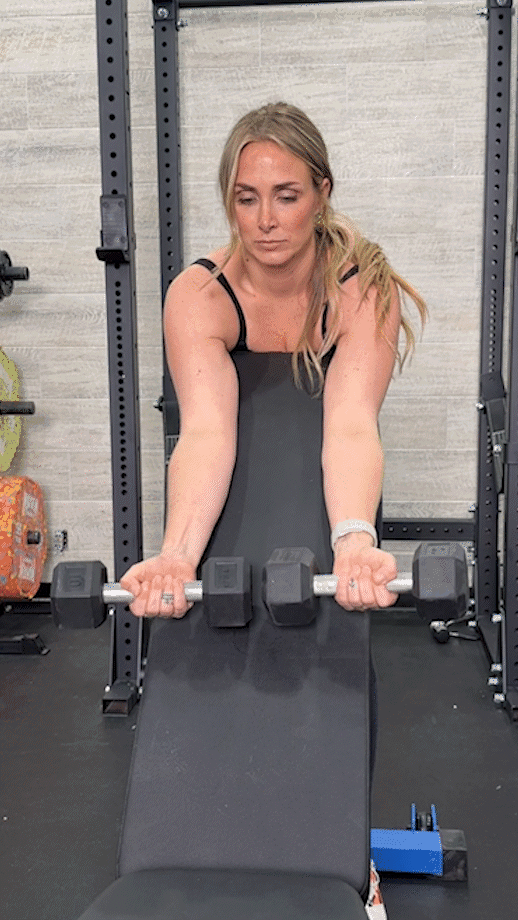
One-Arm Dumbbell Preacher Curl
Why do it: Doing those dumbbell preacher curls as a unilateral exercise takes things a step further, letting you really focus on isolating each side for balanced growth and development.
How to do it:
- Set up your preacher curl station as you would for the standard version. You can also perform this exercise by standing behind an incline weight bench with your arm resting over the top of the pad.
- Grab a single dumbbell, sit down, and extend your arm over the pad.
- Curl the dumbbell to your shoulder, squeezing the bicep at the top.
- Slowly return to the starting position.
- Complete all reps, then switch sides and repeat the set.
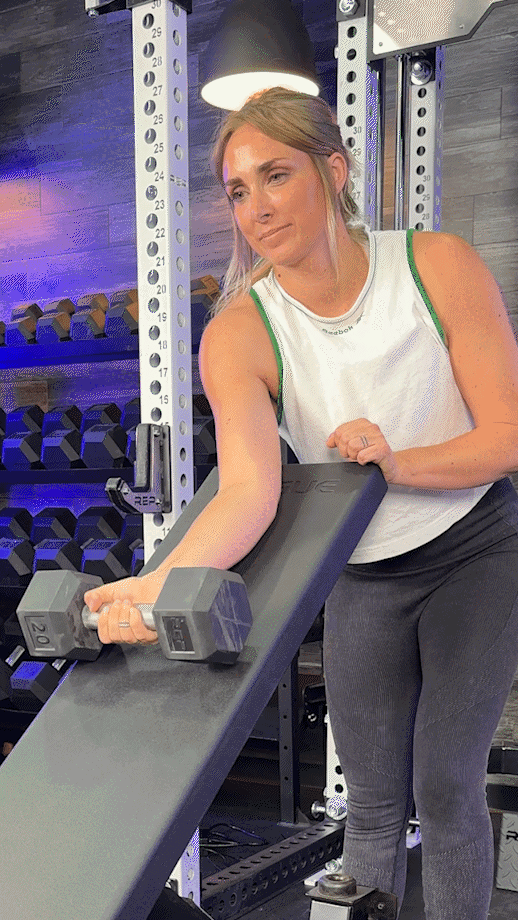
Stability Ball Preacher Curl
Why do it: “Using a stability ball instead of a standard preacher curl bench is beneficial for two reasons,” says Kate Meier, NASM-CPT, USAW-L1, CF-L1. “Most importantly, it adds an element of instability, which helps you work your core, lower back, and glute muscles simultaneously. It also lets you do preacher curls without having to buy an expensive and comparatively less versatile piece of equipment.”
How to do it:
- Place a stability ball on the floor, grab two dumbbells, and lie prone with your chest against the ball and your arms extended. Your elbows should touch the ball.
- Once you’re stabilized, curl the dumbbells toward your shoulders, keeping your core braced in order to minimize the movement of the ball beneath you.
- Squeeze your biceps at the top position, then slowly return to the starting position.
- Repeat as needed.
RELATED: Stability Ball Exercises
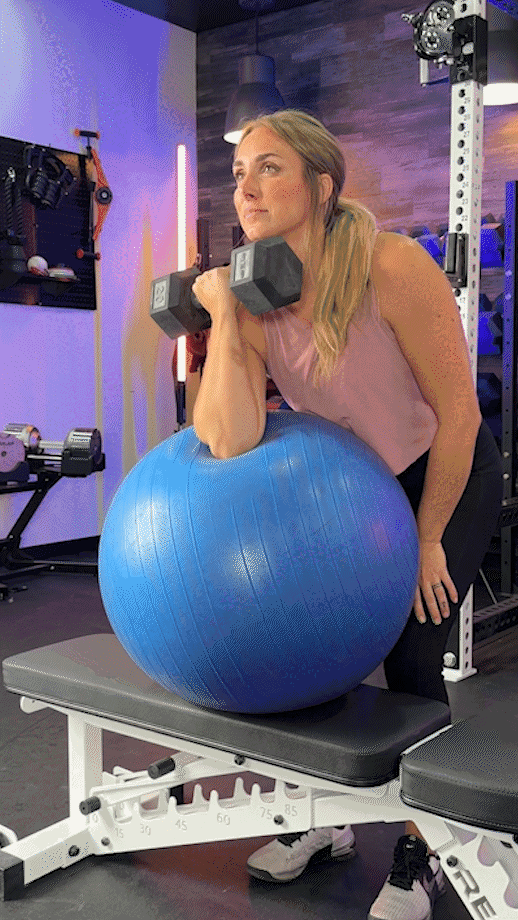
Cable Preacher Curl
Why do it: According to the International Journal of Environmental Research and Public Health3, using a cable-pulley system for the preacher curl instead of free weights changes the stimulus, placing greater torque on your biceps when your elbows are flexed rather than extended, which may result in greater strength and hypertrophy increases.
How to do it:
- Set up your preacher bench near a cable machine or use an incline bench.
- Set the pulley to the lowest position.
- For a straight or undulated bar attachment, grip with two hands. For a single D-handle attachment, grip with one hand. Step back to create tension and extend your arm(s) over the preacher or incline bench, pressing the elbow(s) into the support.
- Curl the attachment toward your shoulders and squeeze the contraction.
- Slowly guide the attachment back to the starting position.
- Repeat as needed. If doing one arm at a time, switch arms and repeat.
RELATED: Cable Biceps Workout
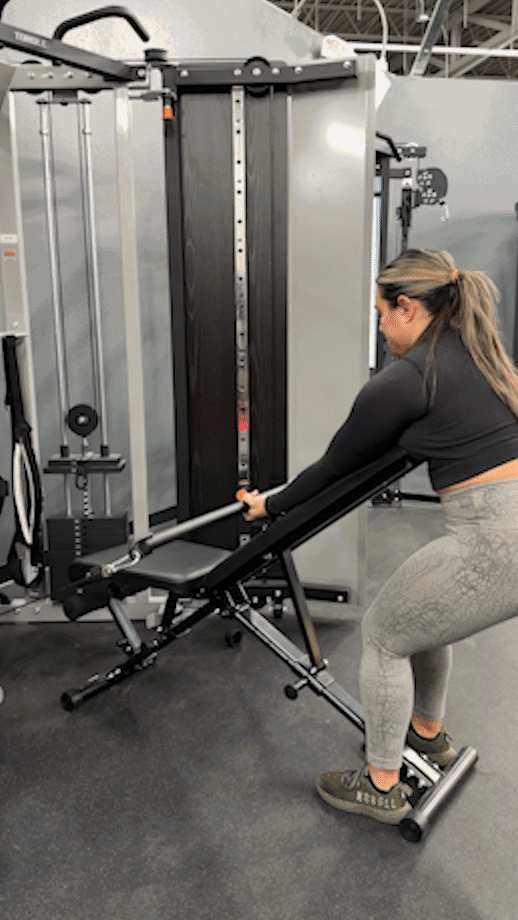
Preacher Curl Alternatives
Preacher curls may be why you’re here today, but they’re not the only way to isolate and activate your biceps muscles. Here are a few alternatives that work just as well for biceps training.
Concentration Curl
Why do it: According to the American Council on Exercise4, the concentration curl is the king of biceps curl variations in terms of EMG activity. That means it’s a must for any and every biceps strength training program.
How to do it:
- Sit on a weight bench with your legs spread wide.
- Grab a dumbbell with your right hand, lean your torso forward, and push your right elbow into your right thigh for support. Allow your right arm to extend between your legs.
- Curl the dumbbell into your chest using just your bicep.
- Squeeze at the top, then slowly bring the weight back down.
- Repeat as needed, then switch to your left hand and repeat the set.
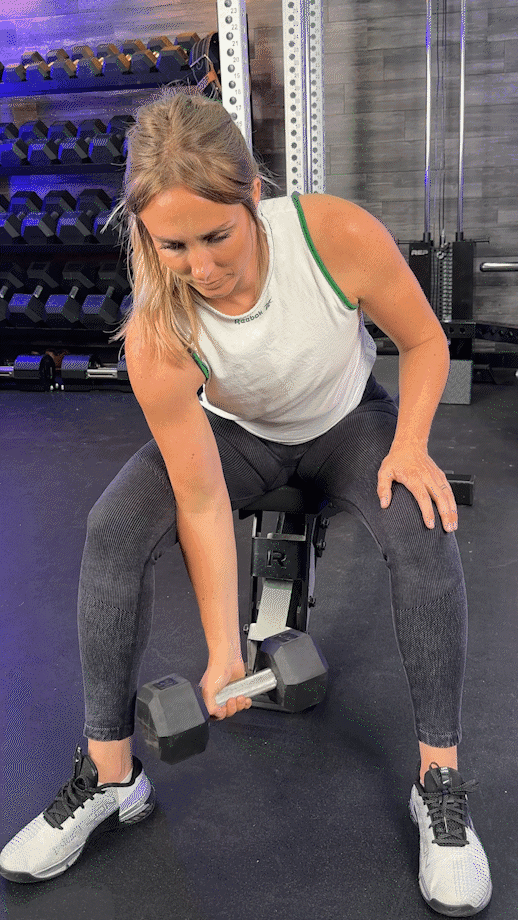
Incline Biceps Curl
Why do it: “The incline biceps curl features a wider range of motion due to the angle you’re at in the starting position,” says Kate. “That means more work per rep and, in turn, more results.”
How to do it:
- Set an incline bench to between 30 and 45 degrees, grab two dumbbells, and sit down with your back against the support pad and your arms dangling at your sides.
- Curl the dumbbells to your shoulders, keeping your elbows as stationary as possible.
- Squeeze your biceps at the top, then slowly return to the starting position.
- Repeat as needed.
RELATED: Best Weight Benches
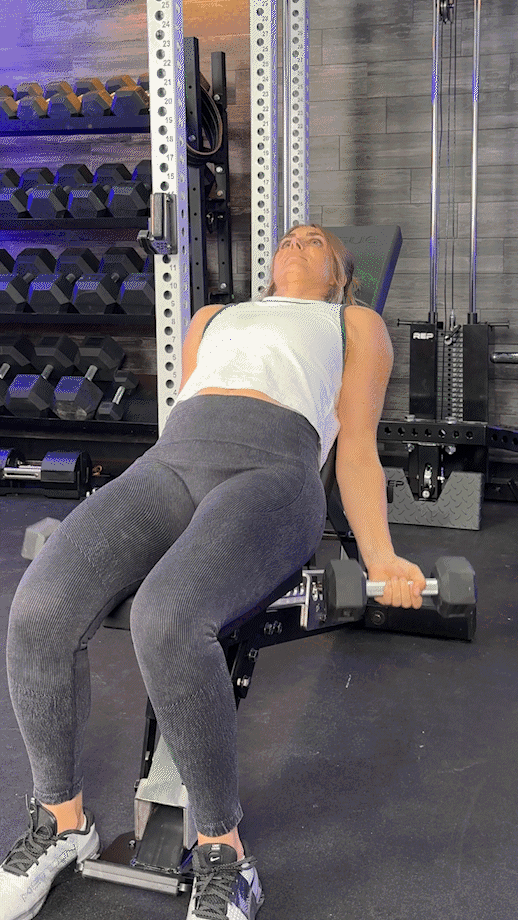
Spider Curl
Why do it: The spider curl does increase biceps activation by stabilizing the upper body against the back of an incline bench and letting you focus solely on a strong contraction. The spider curl does not grant you web-slinging powers and Spidey senses.
How to do it:
- Set an incline bench to between 30 and 45 degrees, grab two dumbbells, and lie prone with your chest against the back pad and your head peeking over the top. Your elbows should be fully extended with your arms dangling towards the floor.
- Curl the dumbbells towards your shoulders by contracting your biceps.
- Squeeze at the top, then slowly extend the elbows to return to the starting position.
- Repeat as needed.
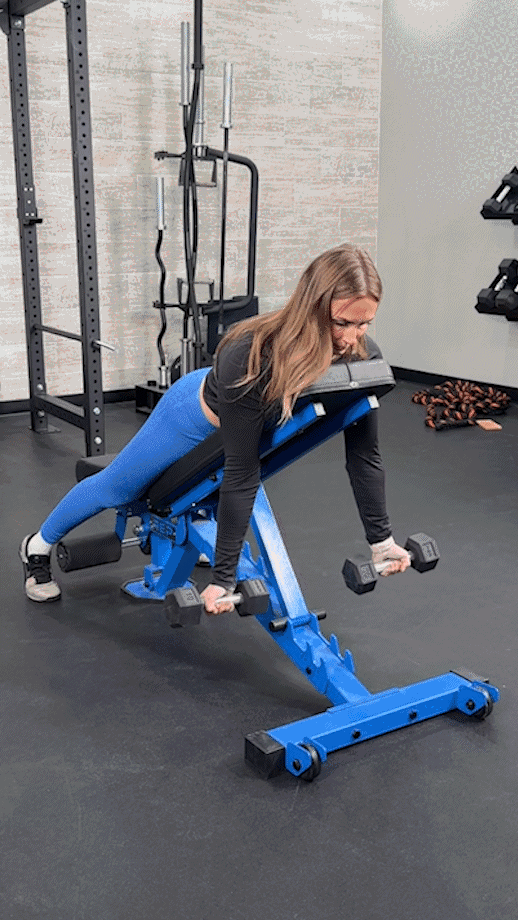
Drag Curl
Why do it: The drag curl involves dragging (as the name suggests) a barbell across your upper body to effectively take the shoulders out of the equation. The result: greater biceps activation, despite the minor decrease in your range of motion.
How to do it:
- Stand with your feet shoulder-width apart and a loaded barbell held with an underhand grip at approximately belly button height.
- Pull your elbows back in order to drag the barbell upwards, contracting your biceps. Keep your chest tall, shoulders down and back, and core tight as you move.
- Continue until you reach your lower chest region.
- Squeeze the biceps at the top, then slowly lower the bar back down.
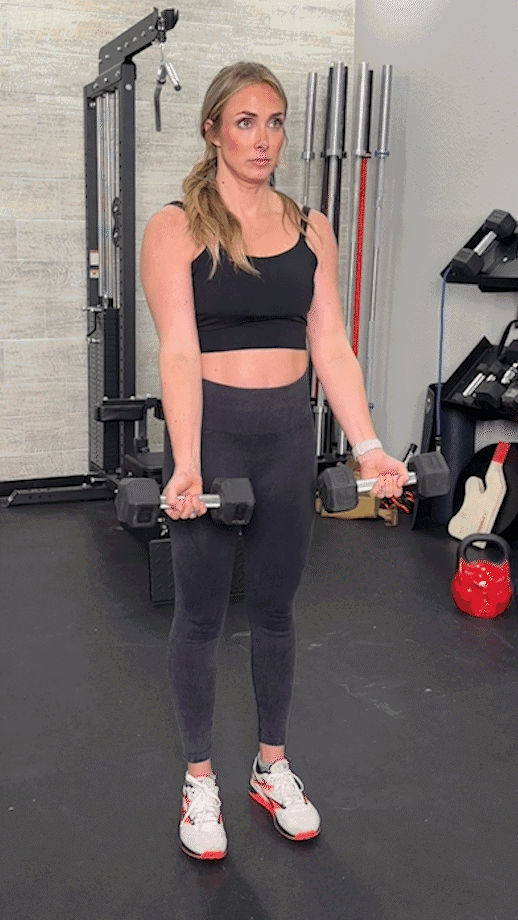
Reverse Curl
Why do it: According to PeerJ5, using an overhand grip rather than a supinated one for your biceps curls increases muscle activation in your forearms, namely the brachioradialis, which should help you build all-purpose muscle size and strength as well as greater grip strength.
How to do it:
- Stand with your feet shoulder-width apart and a loaded barbell held with a pronated grip at approximately waist height. Keep your chest tall, core tight, shoulder blades retracted, and your eyes fixed forward.
- Curl the bar towards your shoulders using your biceps.
- Squeeze the contraction, then slowly return to the starting position.
- Repeat as needed.
RELATED: Grip Strength Exercises
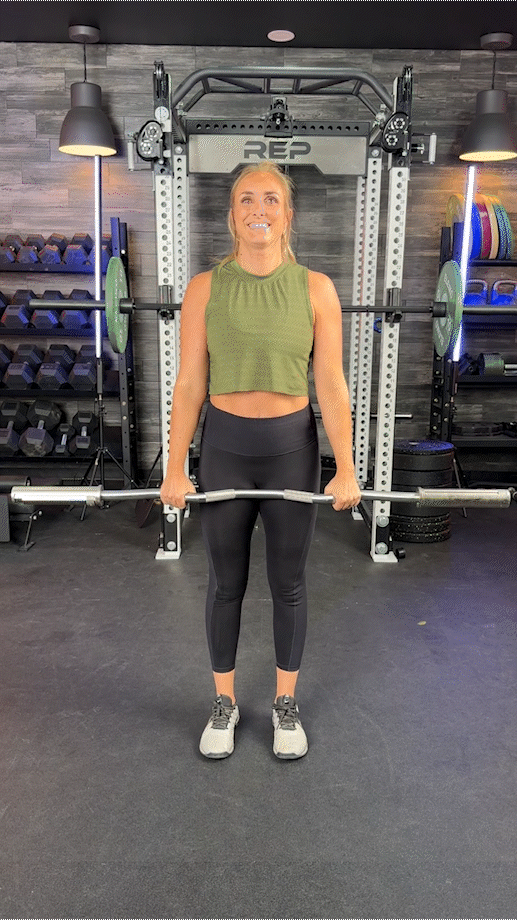
How to Program the Preacher Curl
Performing preacher curls will work wonders for your biceps, but they work best when combined with other complementary exercises.
“Preacher curls make a great addition to an arm workout if you have a designated arm day in your workout split,” says Kate Meier, NASM-CPT, USAW-L1, CF-L1. “Performing them with other biceps exercises, like concentration curls, hammer curls, and chin-ups, helps fully exhaust the biceps muscle and promote growth.”
Supersetting preacher curls with triceps exercises for a push-pull workout is effective, too. Try mixing in exercises like dips, kickbacks, and overhead triceps extensions.
Working your back and biceps together is also a common split. Pairing your preacher curls with bent-over rows, deadlifts, and lat pulldowns tends to work well.
RELATED: Back and Biceps Workout
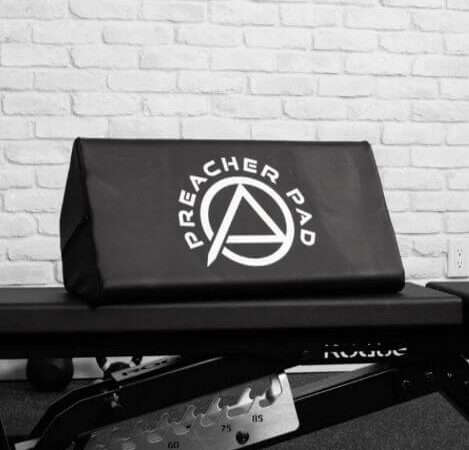
Once you decide when to program your preacher curls, you’ll want to hammer out the deets on the rep scheme. What works best will depend on your personal goals:
- For strength: Aim to do 3 to 5 sets of 3 to 5 reps using heavier weights
- For growth: Do 3 to 6 sets of 6 to 12 reps using moderate weights
- For endurance: Keep it at 2 sets, but get in 15 to 20 reps
For a more personalized plan, consider working with a certified personal trainer or other qualified fitness professional.
Preacher Curl: FAQs
What is the preacher curl good for?
The preacher curl is great for building bigger biceps and increasing biceps strength because it uses the same movement pattern as the standard biceps curl but uses a preacher bench or preacher curl machine to stabilize the torso and elbow joint for maximum isolation.
Are preacher curls or biceps curls better?
For muscle activation, the preacher curl allows for better isolation. So, in that regard, the preacher curl is better than the biceps curl.
However, you perform most real-world movements from a standing position without support, so you’ll need core strength and good posture to perform daily living tasks without hurting yourself. So in that case, the biceps curl is better because it encourages you to maintain a rigid posture and brace your core to a greater degree.
What are the cons of preacher curls?
The preacher curl bench is a blessing and a curse because it supports your elbow joint, so you’re not getting quite as wide of a ROM as the standing barbell curl.
As an isolation exercise, it doesn’t work as many muscles as, for example, the chin-up, seated row, and other compound exercises that activate the biceps.
Should I go heavy on preacher curls?
Not necessarily. Progressive overload is important for strength gains and muscle growth, but the preacher curl is not an exercise where you should try to totally max out.
Instead, choose a weight that is challenging but allows you to use a full range of motion and get a strong biceps contraction at the top.
References
1. Pedrosa GF, Simões MG, Figueiredo MOC, et al. Training in the Initial Range of Motion Promotes Greater Muscle Adaptations Than at Final in the Arm Curl. Sports (Basel). 2023;11(2):39. Published 2023 Feb 6. doi:10.3390/sports11020039
2. Zabaleta-Korta A, Fernández-Peña E, Torres-Unda J, Francés M, Zubillaga A, Santos-Concejero J. Regional Hypertrophy: The Effect of Exercises at Long and Short Muscle Lengths in Recreationally Trained Women. J Hum Kinet. 2023;87:259-270. Published 2023 Jul 15. doi:10.5114/jhk/163561
3. Nunes JP, Jacinto JL, Ribeiro AS, et al. Placing Greater Torque at Shorter or Longer Muscle Lengths? Effects of Cable vs. Barbell Preacher Curl Training on Muscular Strength and Hypertrophy in Young Adults. Int J Environ Res Public Health. 2020;17(16):5859. Published 2020 Aug 13. doi:10.3390/ijerph17165859
4. Young, M.S., S., Porcari, Ph.D., J. P., Camic, Ph.D., C., Kovacs, Ph.D., A.; Foster, Ph.D., C. Ace Study Reveals Best Biceps Exercises. ACE. ProSource™: August 2014
5. Marcolin G, Panizzolo FA, Petrone N, et al. Differences in electromyographic activity of biceps brachii and brachioradialis while performing three variants of curl. PeerJ. 2018;6:e5165. Published 2018 Jul 13. doi:10.7717/peerj.5165
Further reading

Is it safe to use a massage gun for sciatica? Experts answer this common question in our guide to sciatica relief. Read more

If you’re looking for a deal on some of the best weightlifting shoes or other apparel, use a Nike promo code at checkout to save some money. Read more

Our expert guide on the best pool exercises for weight loss can help you trim inches off your waistline by taking your workouts to the water. Read more

We’ve teamed up with celebrity trainer Harley Pasternak to bring you this A-list leg day workout. Read more

